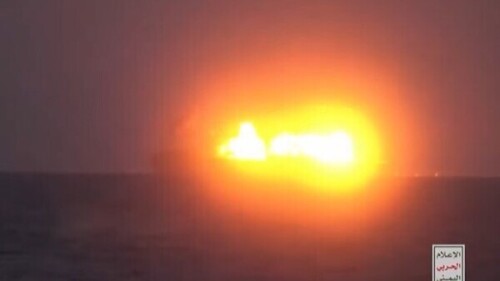At a time when it still controlled large swathes of territory in Syria and Iraq, the Islamic State (IS) released a video entitled “Structure of the Caliphate,” which detailed the structure of administration and the geographic organization of its state project. In that video, IS claimed the existence of 35 wilayas (“provinces”): 19 inside Syria and Iraq, and 16 elsewhere.
Today, the number of wilayas claimed in propaganda appears to have reduced dramatically in number. For example, IS propaganda portrays Syria and Iraq as consisting of just two provinces: a Wilayat al-Sham and Wilayat al-Iraq respectively, with each province consisting of a number of regions. In Libya, three provinces seem to have been similarly condensed: there now appears to be just one province in the country that covers three regions.
Other wilayas still exist as they were when they were first announced in 2014 and 2015:
West Africa, Sinai, Algeria, Khorasan (Afghanistan and Pakistan), and Yemen, which still exists as multiple provinces for now. Meanwhile, two areas where IS has been claiming military operations have now been elevated to the status of provinces: Somalia and East Asia.
These apparent shifts reflect in part the overall collapse of IS as a state project, which was previously its central claim to fame, and the evolution of a global IS insurgency. In places where IS propaganda displays a seemingly simplified provincial structure, the common thread is that they were areas in which IS once exercised significant control of territory with regular photo series and videos advertising governance implementation.
Viewed in this light, IS is mostly a failure as a state project in Iraq, Syria, and elsewhere. Yet how successful one views IS as a global insurgency and terrorist force depends on the criteria one sets. For example, in the Sinai area, IS is the most powerful insurgent force fighting Egypt’s security forces and easily eclipses any al-Qaeda-aligned rivals such as Jamaat Jund al-Islam. And yet, years of insurgency have not given rise to formal control of territory in the Sinai to implement governance, rather it has proven only to be a continual headache for the Egyptian government.
Similarly, the Khorasan province can be viewed as a mixed bag in terms of results, depending on the angles one explores. IS has managed to carve out a small enclave of territory in the east of Afghanistan, siphon off some disillusioned elements of the Taliban, and carry out many deadly suicide bombings targeting the Afghan capital of Kabul. Even so, its overall position in Afghanistan still does not compare with that of its “nationalist” rival.
In other areas, IS activity seems to be almost completely dormant, most notably in Algeria and Saudi Arabia. Previously, IS was particularly keen to make its mark in the latter considering that it is home to the two holiest sites in Islam of Mecca and Medina (hence the name of “Bilad al-Haramain”). Saudi Arabia’s security services, then, have proven largely successful in clamping down on an IS terrorist threat.
Despite the portrayed simplification of the provincial structure in Iraq and Syria and shift in IS’ overall image, one should still remember that there is a central leadership for IS and that this leadership is based in Iraq and Syria. Thus, there is a command-and-control structure between “IS central” and the provinces outside of Syria and Iraq.
As is the case with al-Qaeda and its affiliates though, there are issues surrounding how effective that command-and-control really is. The clearest case-in-point is the IS West Africa province. Previously Jamaat Ahl al-Sunnah lil-Dawa wa al-Jihad (also known as Boko Haram) under Abubakar Shekau, an allegiance pledge was given to IS in March 2015, creating a West Africa province with Shekau as its governor. The move seemed to be an apt propaganda victory for IS at the time, as Shekau’s group controlled some territory in Nigeria. By August 2016 though, that territorial control had gone and Shekau was removed as governor. The result is that while one still has the IS West Africa affiliate, which has been waging an insurgency in northeast Nigeria and the Lake Chad area, there is also the rival movement led by Shekau and his followers, with whom the IS West Africa affiliate has clashed multiple times.
Only recently has the story of the inside trouble in the West Africa affiliate come to light as the affiliate’s leaders released a long book giving a self-history of the movement and a lengthy critique of Shekau, who was removed from his position as governor on account of his disobedience towards the central leadership. In general, the book is useful for understanding what is seen as “too extreme” even for IS: for instance, the idea that Muslims who reside in the “abode of kufr” become non-Muslims simply for residing in such an area. To be sure, Shekau had espoused such ideas well before he gave allegiance to IS, something the book portrays as a step he took out of fear that his leadership position was threatened. In any case, it is clear that the pledge of allegiance to IS had failed to rein in Shekau’s extreme tendencies.
The bigger picture is that IS is far from being “defeated” on the global level despite the general collapse of the state project, something that should come as no surprise. Even if IS can never rise again to the level of success it had in 2014-2015, it will be around as a global terrorist threat and insurgency problem for decades to come.
Aymenn Jawad al-Tamimi is a researcher on violent non-state Islamic and Middle Eastern groups for the Middle East Forum. He has been widely cited in international media outlets including the New York Times, AFP and AP, and the Washington Post. He tweets @ajaltamimi.






